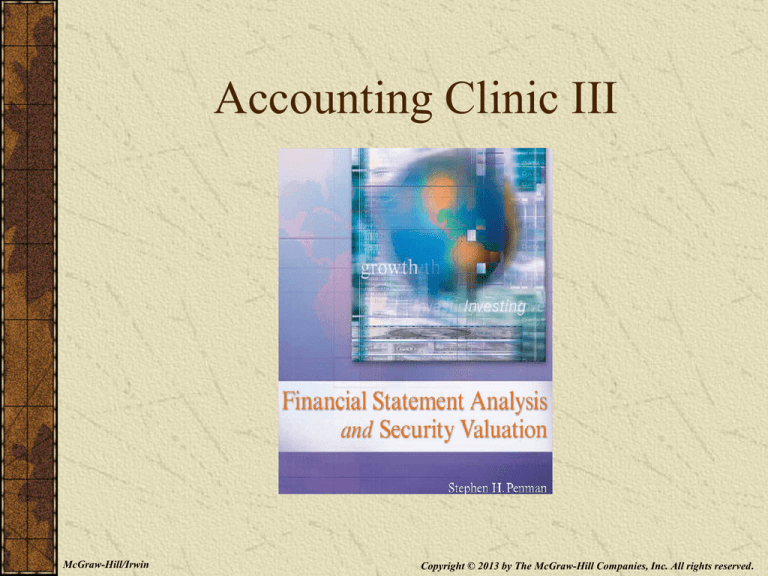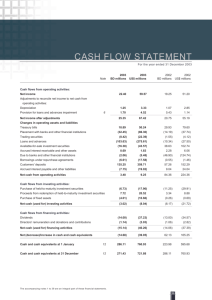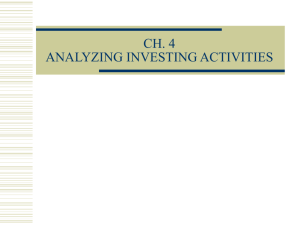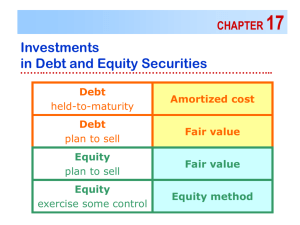
Accounting Clinic III
McGraw-Hill/Irwin
Copyright © 2013 by The McGraw-Hill Companies, Inc. All rights reserved.
With contributions by
Stephen H. Penman – Columbia University
Clinic III-2
Why do Firms Hold Debt and
Equity Securities?
To invest idle funds (usually in debt securities)
As part of their operational plan (usually equity
securities)
In an investment portfolio where investments are
bought or sold
As a permanent investment in affiliates and subsidiaries
Clinic III-3
Classifying Debt and Equity Securities
by their Accounting Treatment
Debt
Held to Maturity
Available for Sale
Equity
Less than
20%
ownership
Greater than
20%
ownership
Available for
Sale
Trading
Trading
Go to
clinic V
Clinic III-4
What are Marketable Securities?
Debt securities
Equity securities representing less then 20%
interest in another corporation
For the accounting for equity securities with
greater than 20% ownership go to
Accounting Clinic V
Clinic III-5
Classifications of Marketable
Securities
Debt securities are classified into one of three
categories:
held-to-maturity
available-for-sale
trading.
Equity securities (representing less then 20%
ownership) are classified into one of two categories:
available-for-sale
trading.
The appropriateness of the classification should be
reassessed at each reporting date.
Clinic III-6
Held-to-Maturity Debt Securities
Investments in debt securities should be classified
as held-to-maturity only if the reporting enterprise
has the positive intent and ability to hold those
securities to maturity.
An enterprise should not classify a debt security as
held-to-maturity if it intends to hold the security
for only an indefinite period.
Clinic III-7
Held-to-Maturity Debt Securities
– The Accounting Rule
Held to maturity are measured at their
historical cost.
If debt were purchased at a discount or
premium over par value, the discount of
premium is amortized to the income
statement.
Clinic III-8
The Effective Interest Method
The effective interest rate is the internal rate of
return or yield to maturity at the time of issue.
Under the effective interest rate method, the
interest expense for a period is calculated as the
effective interest rate times the bonds’ book value
at the beginning of the period. Thus, under this
method, the implied interest rate is constant.
Clinic III-9
Trading Securities and Available-forSale Securities (both Debt and Equity)
Investments in debt securities (not classified
as held-to-maturity) and equity securities
that have readily determinable fair values
should be classified as either:
Trading
available-for-sale
Clinic III-10
Trading Securities
Securities that are bought and held principally
for the purpose of selling them in the near term
(thus held for only a short period of time)
should be classified as trading securities.
Trading generally reflects active and frequent
buying and selling, and trading securities are
generally used with the objective of generating
profits on short-term differences in price.
Clinic III-11
Available-for-Sale Securities
Investments not classified as trading
securities (nor as held-to-maturity
securities) should be classified as
available-for-sale securities.
Clinic III-12
Reporting Changes in Fair Value Unrealized
Unrealized holding gains and losses for trading
securities should be included in net income
Unrealized holding gains and losses for availablefor-sale securities (including those classified as
current assets) should be excluded from net
income and reported as a net amount in other
comprehensive income within shareholders' equity
until realized.
Clinic III-13
Reporting Changes in Fair Value Realized
Dividend and interest income, including
amortization of the premium and discount
arising at acquisition, should be included in
net income (for all securities).
Realized gains and losses should be
included in net income (for all securities).
Clinic III-14
Balance Sheet Presentation
An enterprise should report all trading
securities as current assets in the balance
sheet and should report individual held-tomaturity securities and individual availablefor-sale securities as either current or
noncurrent, as appropriate.
Clinic III-15
Statement of Cash Flows
Cash flows from purchases, sales, and maturities
of available-for-sale securities and held-tomaturity securities should be classified as cash
flows from investing activities and reported gross
for each security classification in the statement of
cash flows.
Cash flows from purchases, sales, and maturities
of trading securities should be classified as cash
flows from operating activities.
Clinic III-16
Example: Marketable Equity Securities –
Journal Entries
Alexis Co. purchased 100 common shares of Ball
Co. on February 1, 2004, for $500,000. The
market value of the shares on December 31, 2004,
was $560,000. Alexis Co. sold these shares on
June 30, 2005, for $600,000.
Give the journal entries to record this transaction
assuming:
the shares are classified as trading securities
the shares are classified as available for sale securities
Clinic III-17
If the shares were classified as
trading securities
February 1, 2004
Marketable Securities
Cash
December 31, 2004
Marketable Securities
Unrealized Holding Gain
on Trading Securities
500,000
500,000
60,000
60,000
The unrealized gain is reported in the income statement
Clinic III-18
June 30, 2005
Cash
Marketable Securities
Realized Gain on Sale
of Trading Securities
600,000
560,000
40,000
The realized gain is reported in the income statement
Clinic III-19
If the shares were classified as
available for sale securities
February 1, 2004
Marketable Securities
500,000
Cash
December 31, 2004
Marketable Securities
60,000
Unrealized Holding Gain
on Available for sale Securities
500,000
60,000
The unrealized holding gain is reported in “other
comprehensive income”
Clinic III-20
June 30, 2005
Cash
Marketable Securities
Realized Gain on Sale
of Trading Securities
600,000
500,000
100,000
The realized gain is reported in the income statement
Clinic III-21
At December 31, 2005 the security adjustment
account had a debit balance of $60,000 ($560,000$500,000). The adjustment entry is as follows:
Unrealized Holding Gain
on Available for sale Securities
Marketable Securities
60,000
60,000
To remove the unrealized gain from shareholder’s
equity.
Clinic III-22
Example: Different Accounting Treatments
for Marketable Equity Securities
Wonder Corporation has the following portfolio of
marketable equity securities:
Cost in
Dividends
received
Market
Value on
Dec. 31,
Dividends
received
Market
Value on
Dec. 31,
Selling
Price on
June 30,
Security
2003
2003
2003
2004
2004
2004
A
$16,000
$1,000
$19,000
$1,200
$17,500
-
B
20,000
1,600
25,000
800
-
$28,500
C
15,000
800
12,000
400
-
10,500
$51,000
$3,400
$56,000
$2,400
$17,500
$39,000
Clinic III-23
A. Assume that these securities represent trading
securities.
How much income would be recognized during 2003
and 2004?
How would these securities be presented on the
balance sheet on December 31, 2003 and 2004?
B. Assume that these securities represent available
for sale securities by Wonder Corporation. How
would your answer to part A change?
Clinic III-24
Solution
A. Trading Securities
Income Statement:
Dividend Revenue
(the total in the dividend column)
Unrealized Holding Gain (Loss):
2003: ($56,000 - $51,000)
2004: ($17,500 - $19,000)
Realized Holding Gain $39,000 ($12,000 + $25,000)
Balance Sheet:
Current Assets:
Marketable Securities
2003
2004
$3,400
$2,400
5,000
(1,500)
-$8,400
2,000
$2,900
$56,000
$17,500
Clinic III-25
B. Securities Available for Sale
Income Statement:
Dividend Revenue
Realized Holding Gain:
[$39,000 – ($15,000 + $20,000)]
2003
2004
$3,400
$2,400
-$3,400
4,000
$6,400
Clinic III-26
B. Securities Available for Sale
Balance Sheet:
Current Assets:
Marketable Securities
Shareholder’s Equity:
Net Unrealized Holding Gain (Loss) on
Securities Available for Sale:
($56,000 - $51,000)
($17,500 - $16,000)
2003
2004
$56,000
$17,500
5,000
--
-(1,500)
Clinic III-27
Disclosures About Securities
FASB Statement No. 115 requires the following
disclosures each period:
The aggregate market value, gross unrealized holding
gains, gross unrealized holding losses, and amortized
cost for debt securities held to maturity and debt and
equity securities available for sale
The proceeds from sales of securities available for sale
and the gross realized gains and gross realized losses on
those sales
Clinic III-28
Disclosures About Securities
The change during the period in the net
unrealized holding gain or loss on securities
available for sale included in a separate
shareholders’ equity account
The change during the period in the net
unrealized holding gain or loss on trading
securities included in earnings
Clinic III-29
Controversy Surrounding the Accounting
for Marketable Securities
The accounting for marketable securities has been
controversial. The accounting issues are as
follows:
Whether to report the investments at historical cost or at
market value on the balance sheet date
If reported at market value, when to record the gain/loss
from the change in market value in the income
statement
• Each period?
• Only when the firm disposes of the investments?
Clinic III-30
Keep in mind…
We have seen that there are two
measurement basis for recording
securities:
Amortized cost
Market value
Which method gives us the a better
estimate of the value of the securities?
Clinic III-31
Amortized cost is based on the historical cost
measurement rule and avoids manipulation in the
financial statements. But historical cost does not
capture any change in value since acquisition.
Market prices give the change in value since
acquisition. But (fair) market values can be biased
if market values are estimated. Actual market
prices can be bubble prices which are not “fair”
value.
Clinic III-32
Fair Value
Fair Value is exit value, that is, what a firm could sell the item
for (or pay someone else to relieve them of a liability).
Fair value is measured in three ways:
Level 1. If there is an active, liquid market for the item: at
market price
Level 2. If there is no available market price: at the price of a
comparable if that is available
Level 3. If there is no comparable price, then the fair value
must be estimated using a valuation model
Clinic III-33







